Invasive Species — European Green Crab (Carcinus maenas)
Biological Characteristics
ALERT!! Invasive European green crabs found in Alaska. Please take photos of any suspect crab and call the ADF&G Invasive Species Hotline to report: 1-877-INVASIV.
CHECK OUT THIS GUIDE!
Washington Sea Grant Crab Team developed an informative guide to teach you the key physical characteristics of invasive European green crabs and native crabs. Learn to identify most crabs you encounter when harvesting, recreating or working along beaches and in the nearshore habitats of Alaska. NOTE: Within the guide, European green crabs are referred to as CAMA. This acronym comes from the first two letters of the scientific name CArcinus MAenas.
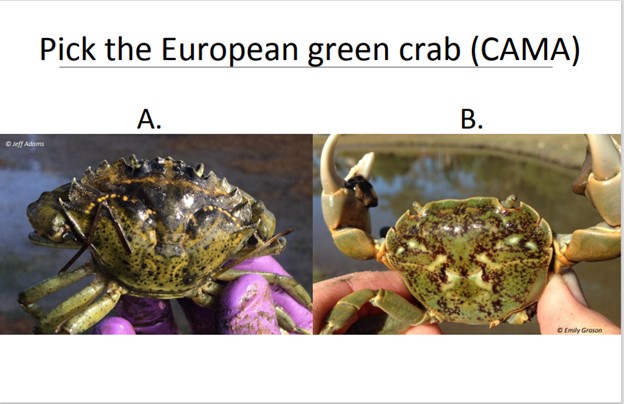
Figure 1 Learn to distinguish invasive European green crabs from native crabs. Characteristics for live crabs and molted carapaces (shells). Thanks to WSG CRAG TEAM.
Washington Sea Grant Crab Team has other information about European green crabs at their website: WSG Crab Team - Washington Sea Grant
European green crabs are classified as banned invasive species in Alaska regulations. Possession and transport of banned invasive species is prohibited. Instead of collecting suspect crabs, take photos from different angles. Place a pencil, key, credit card or other standard sized item next to the suspect crab when photographing. Please submit photos to Tammy Davis.
See Alaska regulation 5 AAC 41.075 for more detailed information and a complete list of banned invasive species or view our FAQ about banned invasive species.
To learn more about European green crabs arrival to Alaska and the harm they pose nearshore environments check out this article from May 2021. This article was written before European green crabs had been detected in Alaska.
Biological Characteristics
European green crabs were first detected in July 2022 at Annette Islands Reserve in southern Southeast Alaska. The European green crab is also commonly known as the European shore crab, and the Invasive green crab.These crabs have been known to be an invasive species in the Pacific Northwest, as far north as British Columbia. Where established, these small, aggressive marine shore crabs can be found in rocky and muddy intertidal and subtidal protected bays, estuaries and saltmarshes.
Identification European Green Crab (Carcinus Maenas)
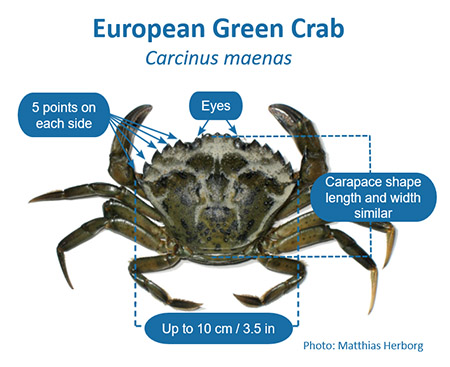
Although the crab's common name would lead one to believe they are always green in color, in fact, their coloration varies. Since there are crabs native to Alaska that may also have green, red or orange shells, such as Dungeness crab, kelp crab, and helmet crab, color is not a good feature by which to identify unknown crabs. The dorsal (top) shell or carapace is often multicolored and mottled, ranging in color from dark or olive green to brown or grey, with yellow patches. The ventral surface (underside) color may change from green to orange and to red during the molting cycle. Rather than color, the most identifiable characteristic of European green crabs is the set of five triangular teeth, or spines, evenly spaced on each side of the carapace margin, located on the outside of the eyes, at the widest part of the shell. Also useful are the three rounded lobes (bumps) between the eyes. The carapace width of an adult European green crab can range up to 4 inches (5.5 to 8 cm) outside of its native range.
While European green crabs may resemble juvenile Dungeness crabs (Cancer magister) in shape, one can always count the spines behind the eyes: Dungeness crabs have 10 small spines, whereas European green crabs have 5 larger spines. Helmet crabs (Telmessus cheiragonous) also tend to be misidentified as European green crabs. The key difference between these two crab species is that helmet crabs have stiff hairs covering their entire body, unlike European green crabs.
- Identification Guide: Selected Crabs of Oregon, Washington, Alaska and British Columbia (PDF 3,340 kB)
- How to Identify a Green Crab (Green Crab Watch Website)
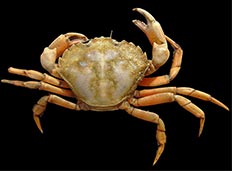
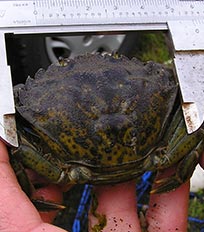
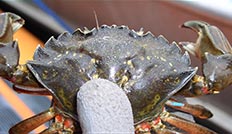
Biology
The European green crab is a crustacean. Crustaceans, like all arthropods, possess segmented bodies with jointed appendages, and shed their exoskeleton in the growth process. Other crustacean features include one pair of mandibles, or jaws, and two pairs of maxillae, or mouthparts, used for feeding, sensory reception, and ventilation from a gill chamber. Crabs have four pairs of walking legs and one pair of claws. Males tend to have longer legs and larger claws than females.
Reproduction
The sexes of European green crab can be distinguished by examining their abdomen and by observing their behavior. The abdomen of males is triangular, whereas that of females is broader and rounder. It is more difficult to distinguish the sexes of small juvenile crabs because their anatomical structures have not differentiated.
Female crabs mate when they are soft-shelled which occurs immediately after molting, or shedding their hard shell. They tend to mate with males that are larger than themselves. After copulation, males will guard females until her shell has hardened. The female carries her brood of fertilized eggs on the underside of her body for several months; the length of time is dependent upon water temperature. A female European green crab can produce one or more broods after copulation.
European green crabs go through six larval stages, 1 protozoea, 4 zoea, and 1 megalopa; each stage is separated by a molting event. Under favorable salinity and food conditions, each stage lasts from 8 to 11 days at 12° C and 4 to 6 days at 18°C. Zoea stages are free swimming and feed on plankton and bacteria. It is during these early life stages that European green crabs travel on currents, as part of the coastal plankton, and potentially expand their range.
